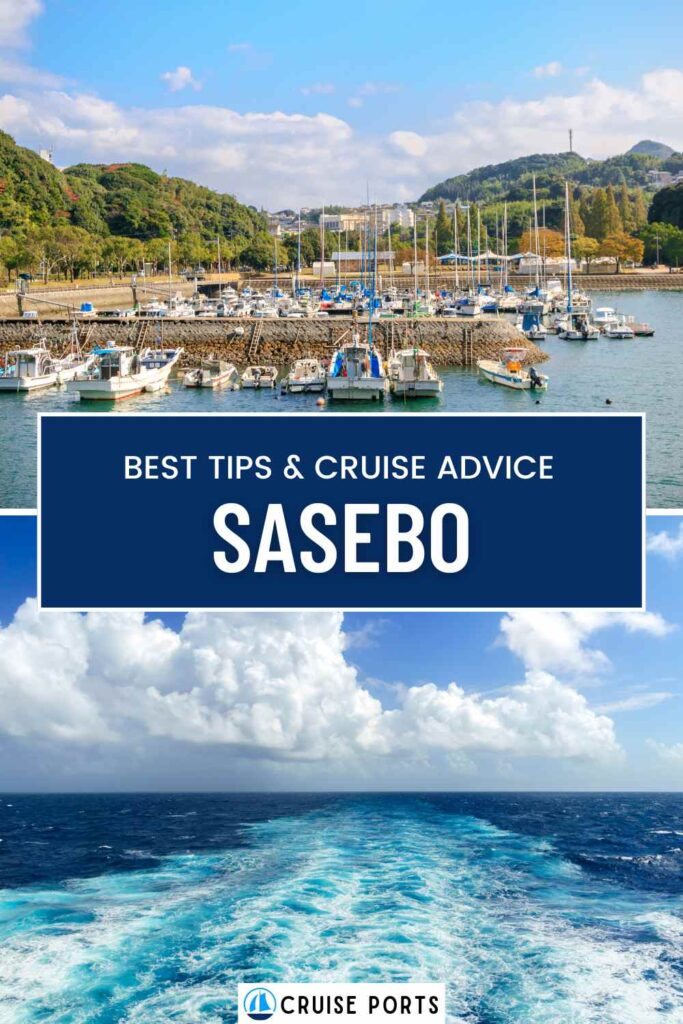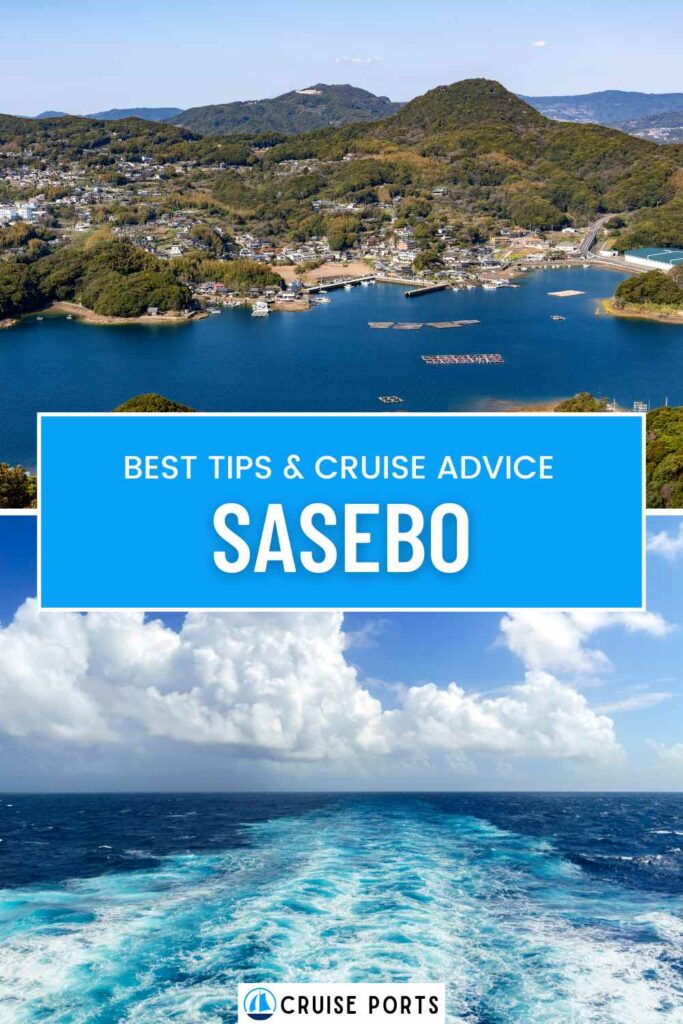Sasebo Cruise Port is a gateway to Japan’s fascinating Nagasaki Prefecture on the island of Kyushu. From striking seaside views to delectable local dishes, this city impresses every visitor.
Dive into a land of world-class shipyards, cultural experiences, and friendly locals, ensuring an unforgettable cruise stop steeped in natural beauty and charm.
Sasebo Cruise Port Overview
Sasebo Cruise Port, located in southwestern Japan’s Nagasaki Prefecture, is a vibrant hub for ships sailing the enchanting waters around Kyushu.
With picturesque coastal vistas and a thriving maritime industry, the port perfectly marries scenic charm and modern convenience.
Whether you’re arriving for a brief shore excursion or an extended stay, Sasebo offers a welcoming atmosphere and an exciting array of activities.

Key highlights of this remarkable port include:
- Ease of Access: Thanks to well-maintained roadways and public transportation systems, getting to and from the cruise terminal is usually straightforward.
- Proximity to Attractions: Sasebo’s bustling core and popular spots like Huis Ten Bosch and Saikai Pearl Sea Resort are within easy reach.
- Seaside Scenic Beauty: Sasebo sits near the famed Ninety-Nine Islands, a cluster of islands offering breathtaking views and boat tours.
- Cultural Mix: Historical influences from Portuguese, Dutch, and Chinese traders blend with Japan’s unique traditions, creating a cultural tapestry that’s distinctly Sasebo.
The port itself boasts clean, modern facilities designed for efficient passenger movement and comfortable waiting areas equipped with basic amenities.
Cruise passengers are often greeted by friendly port staff, eager to assist with directions or recommendations. Strolling through the terminal, you’ll encounter colorful displays showcasing local crafts, souvenirs, and sometimes even mini exhibits introducing Nagasaki Prefecture’s heritage.
Beyond the port, Sasebo is known for its U.S. Naval Base, established post–World War II. This international presence has helped shape the city’s cosmopolitan vibe, reflected in diverse dining options and a welcoming spirit that makes visitors feel right at home.
Whether you’re a history buff, a foodie, or an adventure seeker, Sasebo Cruise Port acts as the perfect starting point for your Kyushu discovery.
Navigating Your Arrival
Arriving at Sasebo Cruise Port is a seamless experience, thanks to efficient services and clear signage directing travelers.
Once you disembark, you’ll find that the cruise terminal is relatively compact, allowing you to quickly grab information brochures, use currency exchange services, or pick up local SIM cards if needed.
How to get around:
- Walking: Many attractions are located close to the port. If you’re up for a stroll, you can explore the nearby shops and waterfront parks.
- Taxi: Taxis are plentiful outside the terminal. Look for properly licensed vehicles with visible meters and friendly drivers who can accommodate luggage.
- Public Transportation: Sasebo’s JR railway station and bus lines make it simple to head further into the city or beyond. Buses often stop near the port, offering easy access to major areas, while the train station is just a few minutes away by foot or taxi.
- Car Rentals: For those who prefer to venture off the beaten path, renting a car allows you to explore Kyushu’s countryside at your own pace.
When navigating, keep in mind:
- Local Customs: People queue politely, so let passengers alight before boarding trains or buses.
- Cash vs. Cards: While credit cards are accepted in many places, small eateries or shops might only take cash (Japanese yen).
- Language Assistance: Though you’ll find some English signage, having translation apps or a pocket phrasebook can help when conversing with locals.
If you’re traveling in a larger group, consider pre-booking a private tour or shuttle for more comfort. Many tour companies operating in Nagasaki Prefecture offer pick-up and drop-off at Sasebo Cruise Port, tailored to your schedule.
This is especially useful if you have limited time in port and want to see as much as possible without the hassle of public transport.
Overall, navigation in Sasebo feels straightforward. With a bit of planning and an eagerness to explore, you’ll find that every corner of this bustling city reveals new treasures—whether they’re coastal panoramas, hidden temples, or unexpected culinary delights.

Essential Local Attractions
Sasebo’s charm lies in its wide range of attractions that cater to history enthusiasts, nature lovers, and families alike.
From beautiful bays to unique theme parks, you can easily fill a day (or two) with memorable experiences.
Top spots to check out:
- Huis Ten Bosch: This Dutch-themed park features European-inspired architecture, seasonal flower festivals, and nighttime illuminations. Wander the canals, hop on gondolas, and savor Dutch-inspired treats for a surreal mix of East meets West.
- Ninety-Nine Islands (Kujukushima): A hallmark of Sasebo’s natural beauty, this archipelago boasts lush islets scattered across the bay. Enjoy a sightseeing cruise from the Saikai Pearl Sea Resort to marvel at the green islands and shimmering waters, or climb nearby observation decks for panoramic photography.
- Saikai National Park: Encompassing the Ninety-Nine Islands region, this park is a haven for hiking, birdwatching, and water sports. Trails wind through forests, leading to captivating vistas of the archipelago below.
- Sasebo Zoological Park and Botanical Garden: Families will love meeting animals in spacious enclosures and strolling through themed gardens showcasing seasonal blooms.
- Tenkaiho Observatory: One of the best viewpoints for the Ninety-Nine Islands, Tenkaiho features a flower-filled field in spring and summer, adding even more color to your scenic shots.
For a taste of historical significance, consider visiting:
- Former Sasebo Navy District: Glimpse remnants of its naval history through architecture and monuments around the city.
- Hidden Christian Sites: Nagasaki Prefecture is recognized for its Christian heritage. Church ruins and museums offer insights into the faith’s secret practice under persecution centuries ago.
All these attractions highlight Sasebo’s versatile appeal: you can experience modern amusement parks by day and tranquil nature by afternoon, followed by cultural intrigue at dusk.
Whether you’re traveling solo or with loved ones, Sasebo’s highlights promise unforgettable snapshots of Japan’s charming southern coast.
Cultural Encounters & Traditions
Sasebo offers a unique blend of Japanese tradition and foreign influence, partly due to its port heritage and longstanding international connections.
Exploring local customs is a delightful way to immerse yourself in the city’s spirit and learn about its colorful past.
Cultural highlights:
- Kunchi Festivals: Rooted in ancient harvest celebrations, local festivals like Sasebo Kunchi showcase energetic dance performances, colorfully adorned floats, and rhythmic drumming. These events often take place in autumn, drawing crowds from across the region.
- Tea Ceremonies: Traditional tea ceremonies are an integral part of Japanese culture, offering a peaceful retreat from daily life. Look for tea houses near temples or cultural centers in Sasebo for a hands-on experience.
- Crafts & Souvenirs: Nagasaki Prefecture is known for its exquisite ceramics and lacquerware. Sasebo, in particular, boasts artisans preserving techniques passed down through generations. Purchasing a locally crafted item not only supports these traditions but provides a meaningful memento of your trip.
Because of its historic ties to international trade, Sasebo has also adopted cultural practices and architecture from Europe and beyond.
A stroll through certain neighborhoods reveals design elements reminiscent of Dutch or Portuguese enclaves. You might even catch local dishes infused with foreign twists (like Sasebo Burgers, introduced through the American base presence).
For a deeper experience, consider:
- Visiting a Local Shrine: Learning Shinto rituals is enlightening, especially if you coincide with a festival day.
- Attending a Kimono Workshop: Some cultural centers in Sasebo offer kimono dressing sessions followed by photo opportunities in scenic spots around the city.
- Joining Community Events: If timing allows, volunteer-led gatherings or local markets provide a chance to meet residents and discover lesser-known crafts or delicacies.
One of the most fulfilling aspects of visiting Sasebo Cruise Port is witnessing how centuries-old traditions still thrive amidst modern life. From shrines nestled in quiet corners to festive celebrations bursting with life, Sasebo’s cultural tapestry is both welcoming and endlessly fascinating.

Culinary Adventures
No trip to Sasebo is complete without indulging in its mouthwatering cuisine.
The city’s gastronomic landscape blends fresh local ingredients, foreign influences, and time-honored Japanese cooking techniques. Prepare to tantalize your taste buds with a variety of dishes, each with its own story.
Must-try specialties:
- Sasebo Burger: A legacy of the U.S. Naval Base’s influence, this burger stands out for its juicy patty, crispy bacon, fresh veggies, and tangy sauces. Many shops claim the “original” recipe, so don’t be shy about trying a few versions.
- Chanpon & Sara Udon: Nagasaki Prefecture is renowned for these noodle dishes. Chanpon features a rich broth loaded with seafood and vegetables, while Sara Udon is stir-fried noodles served with a savory topping.
- Fresh Seafood: Being close to the Ninety-Nine Islands means abundant seafood. From sashimi to grilled fish, local chefs celebrate the ocean’s bounty with minimal seasoning to let the natural flavors shine.
- Castella Cake: Originating from Portuguese traders in Nagasaki, this soft, sweet sponge cake remains a popular souvenir. Different shops offer subtle variations in texture and sweetness.
If you crave variety, wander into the city center near the port. You’ll discover:
- Izakayas (Japanese Pubs): Taste an array of small plates like tempura, yakitori, and seasonal pickles. Pair them with a cup of sake or shochu for the full experience.
- Ramen Spots: Although Nagasaki Champon is the star, you can still find classic ramen joints serving tonkotsu or shoyu broths that warm you up on a chilly evening.
- Street Food Stalls: Local festivals or weekend markets occasionally host stalls dishing out skewers, sweet treats, and comfort foods made with local produce.
For the food enthusiast, consider enrolling in a cooking class to learn about Japan’s celebrated culinary tradition.
Some classes include visits to local markets, where you’ll see the region’s high-quality seafood, vibrant vegetables, and artisanal products up close. Sasebo’s culinary adventures promise an authentic taste of Kyushu’s best offerings, fused with the port city’s global heritage.
Shore Excursions & Day Trips
While Sasebo itself brims with engaging activities, its strategic location makes it an excellent launchpad for exploring Nagasaki Prefecture and beyond.
From scenic natural escapes to historical gems, there’s something for everyone on a day trip.
Popular Excursions:
- Nagasaki City: Roughly an hour away by train, this city is famed for its rich history, including the Atomic Bomb Museum, Peace Park, and Dejima. Witness how Nagasaki rebuilt itself as a lively metropolis while preserving the memory of its wartime past.
- Shimabara Peninsula: Venture to the Unzen Onsen area, known for its hellish hot springs, steamy landscapes, and relaxing ryokan stays. The swirling mist and unique geothermal features make for an otherworldly experience.
- Goto Islands: For a more off-the-beaten-path adventure, head to the Goto archipelago. Pristine beaches, hidden churches, and lush greenery await those seeking solitude and cultural immersion.
- Hirado: This small coastal town boasts a historic castle, centuries-old churches, and scenic vantage points. It’s an easy drive or bus ride from Sasebo and provides an intimate look into Japan’s feudal and missionary history.
To get the most out of your limited time, consider the following:
- Guided Tours: Many local guides offer day trips customized for cruise passengers, ensuring you’re back at the port before departure.
- Self-Guided Exploration: If you’re comfortable navigating trains and buses, purchase a JR Kyushu Pass or local bus passes to traverse the region efficiently.
- Timing & Schedules: Check the cruise itinerary and local transport timetables, especially on weekends or holidays when services might be limited.
In addition to these well-known excursions, local tourism offices frequently promote seasonal trips like flower-viewing tours in spring or winter illuminations.
Whether you choose a short trip to Nagasaki City or an extended journey into the volcanic landscapes of Unzen, each excursion offers a deeper appreciation for the diverse wonders of Kyushu.
Travel Tips & Practical Info
To ensure a smooth and enjoyable stop at Sasebo Cruise Port, it helps to be prepared. From currency matters to etiquette, these practical tips will empower you to navigate Sasebo with confidence.
Money & Exchange
- Currency: Japan uses the yen. Many establishments accept major credit cards, but it’s wise to carry some cash for smaller shops.
- ATMs: Convenience stores like 7-Eleven and Lawson usually have ATMs that accept foreign cards.
- Tipping: Not customary in Japan; a simple “thank you” or small gift is more common than handing over extra cash.
Language
- English Signage: Increasingly common in tourist areas, but still limited in residential zones.
- Translation Apps: Useful for instant communication.
- Politeness: Simple words like “Arigato” (thank you) or “Sumimasen” (excuse me) go a long way in building rapport.
Local Etiquette
- Shoes Off: Remove footwear when entering a home, traditional inn, or some temples.
- Queueing: Form lines at train doors or counters and wait patiently for your turn.
- Litter & Smoking: Public trash bins can be scarce, so hold onto your garbage until you find the right disposal spot. Smoking is allowed only in designated areas.
Connectivity
- Wi-Fi: Free Wi-Fi is offered at many cafes and some public areas, though coverage may be patchy. A portable Wi-Fi router or local SIM can help ensure constant connectivity.
- Plug Type: Japan uses A-type plugs (same as North America), with 100V supply. Check your device’s compatibility or bring a converter.
Safety
- General Security: Japan is famously safe, but remain vigilant in crowded areas.
- Emergency Numbers: Dial 110 for police and 119 for fire or ambulance.
- Insurance: Travel insurance is recommended for unexpected medical or travel mishaps.
Staying mindful of local customs, carrying a few travel essentials, and planning your itinerary ahead of time will help you make the most of your Sasebo visit.
Whether you’re hitting the bustling markets, relaxing by the harbor, or trekking through lush landscapes, you’ll find that preparation paves the way for a smooth and memorable journey.
Best Time to Visit
Sasebo Cruise Port welcomes ships year-round, but timing your visit can enhance your overall experience. Each season offers distinct visual beauty and cultural events that may coincide with your port schedule.
Spring (March–May)
- Cherry Blossoms: Early April sees Sasebo covered in sakura blooms. Parks, temple grounds, and the Tenkaiho Observatory become pastel wonderlands.
- Mild Weather: Pleasant temperatures allow comfortable exploration without humidity.
- Festivals: Spring is festival season, so expect lively parades and street food stalls.
Summer (June–August)
- Vibrant Greenery: The Ninety-Nine Islands dazzle with lush landscapes. Great time for boat tours and coastal hikes.
- Humidity & Rain: June and July can bring heavy rain, so pack waterproof gear.
- Fireworks & Matsuri: Japanese summer festivals, or matsuri, often include spectacular fireworks over the bay.
Autumn (September–November)
- Colorful Foliage: Mountains and parks transform into a canvas of red, orange, and gold leaves.
- Comfortable Temperatures: Ideal for sightseeing, with less rain than summer.
- Harvest Festivals: Taste seasonal specialties like persimmons and sweet potatoes, and enjoy local cultural celebrations like Kunchi festivals.
Winter (December–February)
- Mild Winter: While it can get chilly, snow is rare in Sasebo’s coastal regions.
- Illuminations: Huis Ten Bosch’s winter illumination events light up the nights, creating a festive ambiance.
- Fewer Crowds: With fewer visitors, it’s a peaceful time to explore museums and historical sites.
Choosing the best time to visit depends on your interests:
- Nature Lovers might prefer spring or autumn for the best scenery.
- Festival Enthusiasts can plan around local cultural events in summer or autumn.
- Bargain Travelers might enjoy winter’s quieter season and potentially lower hotel rates.
No matter which season you choose, Sasebo Cruise Port provides a memorable blend of natural beauty, cultural experiences, and seaside relaxation, making every month worth considering.


